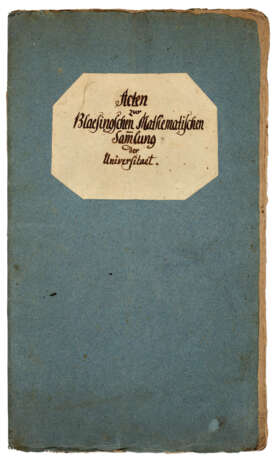ID 887777
Lot 4 | Manuscript Inventory of a Seventeenth-Century Scientific Collection
Estimate value
$ 2 500 – 3 500
Folio, 360 x 215mm. 20 pp. of inventory and approx. 6 pp. of correspondence, ink on paper with 2 red wax seals. Contemporary sewn blue paper wrappers with paper manuscript label (faint crease to center, minor soiling).
An important catalogue of the scientific cabinet of the mathematician and astronomer David Blaesing in Königsberg (1660–1719), one of the eight founding members of the Berlin Academy of Sciences instigated by Leibniz (who became its first president). Blaesing focused on mathematical, optical and physical instruments, globes, minerals and naturalia. He bequeathed his library and cabinet to the Königsberg University. There is no printed catalogue of the collection and the present manuscript seems to be the only detailed record of its contents.
The manuscript was compiled between 1820 and 1824 and consists of four catalogues with accompanying correspondence. From the latter we learn that the contemporary curator of the collection was Karl Gottfried Hagen (1749-1829), an important pharmacist, a close friend of Immanuel Kant, and son-in-law of the mathematician and astronomer Friedrich Wilhelm Bessel. This documentation of Blaesing’s bequest was due to considerable losses the collection had undergone, and Hagen urges the Königsberg University to relocate the remaining collection and to appoint a new curator (the mathematician K. F. Wrede, 1766-1826). The four catalogues are all in Hagen’s hand.
The first catalogue is Hagen’s copy of the inventory of the bequest of mathematical and optical instruments, drawn up in October 1720 shortly after Blaesing’s death. It lists 184 items on eight pages. Among the items listed are: Speculum concavum; 8 Vergroesserungsglaeser (eight magnifying glasses); 2 nicht gefasste Convex-Glaeser (two convex glasses without mounting); 2 Convexglaeser zu Brillen (two convex lenses for spectacles); tubes and lenses for the Camera obscura; Oculus opticus mit einem Kanal von Blech (with a brass tube); several terrestrial telescopes; a lanterna magica; an ocular with coloured glass and micrometer; prismata triangularia made of glass; mounted convex and polyhedral glasses; two microscopes with small optical pictures and numerous other microscopes; pieces of coloured glass (seven blue, three green, four red); several perspectives of different lengths covered with vellum or brass, some of them from the Netherlands; eleven small lenses for microscopes and six for telescopes; another lot of nine glasses for telescopes, one of them green; a Conus astroscopicus von Pappe.
The second catalogue is Hagen’s autograph copy of an inventory of Blaesing’s physics instruments and naturalia, drawn up by the physicist Karl Daniel Reusch (1735-1806) in 1769-70. It lists 82 items on four pages, and includes 67 mineral specimens. The instruments include a glass blowpipe; a small glass sphere covered with mercury inside (a spherical mirror); a pear-shaped apparatus of blown glass; two small pieces of Vitrum antimonii; 2 Diaboli Cartesiani; a large piece of Marienglas; two glass eyes; another spherical mirror; blue glass; thermometers and barometers, etc.
Hagen’s third catalogue lists the mathematical instruments still present in 1820 (named inventory A at top and correspondingly in his draft letter, where he also explains that most of the physical instruments and the naturalia had already disappeared by then). This list comes to 122 items on four pages. Hagen describes the pieces he saw himself with more precision than his predecessors. He identifies a pair of globes by Blaeu and the glasses are listed in more modern terms, e.g. diopters; spherical mirrors made of glass; six bars of blue glass; a four-sectioned Dutch telescope; 31 glass lenses, partly mounted; a six-sectioned terrestrial telescope of three-foot length and covered with coloured vellum; the lanterna magica again, made of iron with a metal mirror, the glass lenses now lacking; a glass lens of one-inch in diameter, mounted with wood; etc. The fourth and last catalogue (named B) lists all the mathematical and optical instruments lacking and probably stolen, according to an inventory also drawn up by the aforementioned K. D. Reusch in 1769-70. It should be pointed out that the inventories copied by Hagen no longer exist, so these are the only surviving records.
The accompanying correspondence consists of a draft letter (with corrections and insertions) by Hagen addressed to the University Senate and presenting the results of his researches on the collection; a protocol for handing over the remaining pieces to Wrede in 1824 with the latter’s autograph signature; and two official letters from the Königsberg University addressed to Hagen (with red wax seals), exculpating him from any responsibility for the losses and directing the relocation of the remaining collection under Wrede's directorship.
| Artist: | David Blaesing (1660 - 1719) Karl Gottfried Hagen (1749-1829) |
|---|---|
| Place of origin: | Europe |
| Auction house category: | Letters, documents and manuscripts |
| Artist: | David Blaesing (1660 - 1719) Karl Gottfried Hagen (1749-1829) |
|---|---|
| Place of origin: | Europe |
| Auction house category: | Letters, documents and manuscripts |
| Address of auction |
CHRISTIE'S 8 King Street, St. James's SW1Y 6QT London United Kingdom | |
|---|---|---|
| Preview |
| |
| Phone | +44 (0)20 7839 9060 | |
| Buyer Premium | see on Website | |
| Conditions of purchase | Conditions of purchase |




